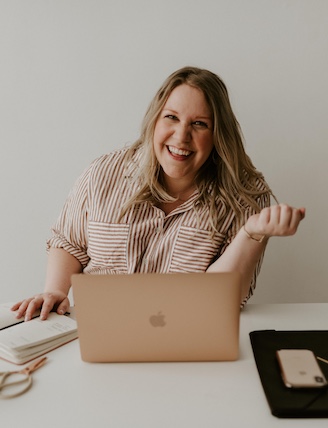What Is A Personal Line Of Credit, And How Does It Work?
Author:
Miranda Crace
Jun 3, 2024
•6-minute read
Unexpected expenses or large purchases can be difficult to handle when you’re living on a budget. A personal loan can provide you the funds to pay a debt in full and then repay the lender over time, but a personal line of credit may be worth considering if you want a little more flexibility.
Let’s discover how a personal line of credit works and see if it’s right for your situation.
How Does A Personal Line Of Credit Work?
Sometimes abbreviated PLOC, a personal line of credit is a form of revolving credit where you can draw from an available balance during what’s known as a “draw period.” Using a PLOC is similar to borrowing with a credit card, in that you can withdraw money up to your credit limit as needed and pay back only what you take out (plus interest on the amount you borrowed).
Personal lines of credit are often unsecured (in other words, no collateral) and approved based on your creditworthiness. Borrowers approved for a line of credit will have access to a certain amount of money for a set period of time. For example, if you’re approved for a $5,000 line of credit with a draw period of 3 years, you can withdraw from that $5,000 balance as many times as you wish over 3 years while repaying what you take out.
What Can You Use A Personal Line Of Credit For?
Personal lines of credit, like personal loans, can be used for a variety of reasons, including but not limited to paying for:
Line Of Credit Vs. Loan
Personal lines of credit and loans can be used for similar purposes, but they differ in significant ways. Following are some examples:
- Open-ended vs. closed-ended: PLOCs are open-ended transactions, meaning the borrower can repeatedly draw from their account up to their credit limit. A personal loan is disbursed as a lump-sum payment into the borrower’s checking account in what’s known as a closed-end transaction.
- Repayment: The repayment process for a PLOC can be based on how much you borrow at a time, though you’ll typically have a minimum monthly amount due. Lenders can offer different repayment plans, too, as we’ll see later. Loans typically come with fixed monthly payments a borrower makes for the life of the loan.
- Interest rates: While loans typically feature fixed interest rates, which don’t change throughout the loan term, PLOCs tend to have a variable annual percentage rate (APR) that can fluctuate throughout your draw and repayment periods.
Personal Line Of Credit Repayment Plans
The draw period refers to the length of time you can withdraw funds from your line of credit. If that period ends and you still have an unpaid balance, what follows is a “repayment period” during which your lender will expect to be reimbursed in one way or another. However, at least one PLOC – described last in the examples listed below – can demand repayment before the repayment period even begins.
Here’s a quick breakdown of three personal line of credit repayment plans:
- Monthly payments: Here, the draw period ends and the repayment period begins with required monthly payments.
- A balloon payment: Some lenders will request a balloon payment (which is a single full repayment of your outstanding balance) at the end of the draw period.
- A demand line of credit: In rare instances, lenders put forward a demand line of credit repayment plan, meaning they can request full repayment whenever they wish.
Personal Line Of Credit Requirements And Fees
Qualifying for a personal line of credit involves many of the same requirements as getting a personal loan. These include:
- A good or excellent credit score
- A healthy debt-to-income (DTI) ratio
- A stable income that makes payments affordable
Personal lines of credit can also come with additional fees, and the types of fees you owe can vary depending on your lender. Expect some or all of these types of fees:
- Origination fees
- Annual or monthly maintenance fees
- Late payment surcharges
- Prepayment penalties
How To Get A Personal Line Of Credit
Personal lines of credit are available through traditional banks, credit unions and online lenders. Before shopping around with different lenders, though, check your credit report to determine what you can qualify for.
Once you know where your credit stands and the amount you need to borrow, research different lenders and see who can offer you the best deal. Prequalifying can also help you know what rates and terms you can expect.
Once you decide on a lender and submit an application (typically with a hard inquiry), you’ll wait for approval or denial. If approved, you’ll then have access to your requested line of credit via checks or cards from your lender.
Pros And Cons Of Personal Credit Lines
Is a personal line of credit right for you? Review some of the benefits and drawbacks to this financing option before you decide.
Pros
- Fast and flexible access to your funds
- Interest only being required on what you use
- Reusable cash flow for the duration of your draw period
Cons
- Variable interest rates that can fluctuate throughout the draw period
- Extra monthly and annual fees from the lender
- Trouble getting approved if you’re a lower-credit applicant
Should You Get A Personal Line Of Credit?
Personal lines of credit work well for some borrowers but not all. The pros and cons listed above should help you determine whether a PLOC seems like a good fit.
Regardless of your decision, you shouldn’t borrow money in any form if you’re unsure whether you can pay it back. While a PLOC is typically unsecured, failing to make payments can negatively affect your credit score and will make it hard to be approved for any loans or credit lines in the future.
Alternatives To A Personal Line Of Credit
If a personal line of credit doesn’t suit your situation, consider these other options for borrowing money.
Personal Loan
We’ve discussed personal loans throughout this article, and they work similar to personal lines of credit in most ways except disbursal and repayment. As noted earlier, personal loans go out in a lump sum that a borrower repays via fixed monthly installments over the loan’s term. Some borrowers prefer a monthly payment that’s always the same, along with a fixed interest rate, as opposed to the variable rates that usually come with PLOCs.
Home Equity Loan Or HELOC
A home equity loan, like a personal loan or personal line of credit, can be used for almost anything. The caveat is that the loan is secured by your home itself, which serves as the collateral, so your lender can take your house through foreclosure if you default on the loan.
Similarly, a home equity line of credit (HELOC) is also secured by your home, with the same consequences if you fail to make your payments. A HELOC functions much the same way as a personal line of credit.
0% APR Credit Card
Some card issuers offer promotional periods where repayments are interest-free for a limited time (typically 12 – 18 months) for borrowers signing up for new cards. If you can repay your full balance within that time period, you can save on interest. If not, you could be subjected to high credit card rates once your promotional period ends.
Emergency Fund
An emergency fund can help you afford untimely or unexpected costs, without going through an approval process or dealing with interest rates. Just make sure you have enough saved up and that you won’t deplete your entire emergency fund with your expenses.
FAQs About Personal Lines Of Credit
Where can I get a personal line of credit?
Personal lines of credit are available through many traditional banks, credit unions and online lenders. Always borrow from reliable or known lenders and beware of predatory lenders waiting to take advantage of those in need of funds.
Are there personal lines of credit for bad credit?
It can be very difficult to get approved for a personal line of credit if you have a low credit score, although approval may still come – with high interest rates. Take steps to improve your credit before applying for a PLOC.
How long does a personal line of credit last?
Personal lines of credit are temporary, and draw periods typically last 3 – 5 years. At the end of your draw period – and after you’ve repaid your full balance – you’ll have to reapply for the line of credit.
Final Thoughts
The revolving nature of a personal line of credit can make for a useful and flexible means of paying off large expenses and emergency costs. Being able to withdraw and repay cash as you need it while only paying interest on what you take can be a huge boon for borrowers. However, keep in mind the variable interest rates and lender fees associated with PLOCs when deciding on your financing option.
Curious about the personal loan rates and terms you qualify for? Start the approval process today with Rocket Loans℠.

Miranda Crace
Miranda Crace is a Senior Section Editor for the Rocket Companies, bringing a wealth of knowledge about mortgages, personal finance, real estate, and personal loans for over 10 years. Miranda is dedicated to advancing financial literacy and empowering individuals to achieve their financial and homeownership goals. She graduated from Wayne State University where she studied PR Writing, Film Production, and Film Editing. Her creative talents shine through her contributions to the popular video series "Home Lore" and "The Red Desk," which were nominated for the prestigious Shorty Awards. In her spare time, Miranda enjoys traveling, actively engages in the entrepreneurial community, and savors a perfectly brewed cup of coffee.
Related Resources
4-minute read
How To Get Low-Interest Personal Loans
Low-interest personal loans can be useful financial tools, but certain factors can determine your rate. See how you can get a personal loan with low interest.
Read more
7-minute read
A guide for understanding home improvement loans
Home improvement loans can help you finance anything from a few cosmetic changes to a major renovation. Figure out what loan option is right for you.
Read more

7-minute read
Different types of personal loans
There are different types and categories of personal loans, each designed for unique purposes. Here’s how each one works.
Read more